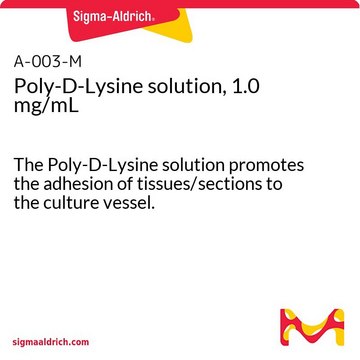P7405
Poly-ᴅ-Lysine Hydrobromide
synthetic, mol wt >300,000, powder, γ-irradiated, suitable for cell culture, BioXtra
Synonyme(s) :
PDL
About This Item
Produits recommandés
product name
Poly-D-lysine hydrobromide, mol wt >300,000, lyophilized powder, γ-irradiated, BioReagent, suitable for cell culture
Source biologique
synthetic (chemical)
Niveau de qualité
Stérilité
γ-irradiated
Gamme de produits
BioReagent
BioXtra
Forme
lyophilized powder
Poids mol.
>300,000
Conditionnement
pkg of 5 mg
Concentration
0.016—0.032 mmol lysine
Technique(s)
cell culture | mammalian: suitable
Couverture de surface
4 μg/cm2
Solubilité
H2O: soluble 50 mg/mL, clear, colorless
Conditions d'expédition
ambient
Température de stockage
−20°C
Chaîne SMILES
O=C(C)[C@@](NC)([H])CCCCN.[Br]
InChI
1S/C6H14N2O2.BrH/c7-4-2-1-3-5(8)6(9)10;/h5H,1-4,7-8H2,(H,9,10);1H
Clé InChI
MEXAGTSTSPYCEP-UHFFFAOYSA-N
Vous recherchez des produits similaires ? Visite Guide de comparaison des produits
Description générale
Application
- in preparing the surface of coverslips for cell attachment
- in coating glass-bottom dishes for live cell imaging of primary cortical neuronal cells
- in coating 24-well plates for the isolation of primary astrocytes to study the impact of melanoma-derived exosomes on the reprogramming of stromal cells within the metastatic microenvironment
- for coating 16-well chamber slides to study the effects of maternal immune activation on behavioral impairments and alterations in cytokine and synaptic protein expression in the cerebellum
Il est recommandé d'utiliser ce produit comme substrat de culture cellulaire, à raison de 0,5 à 1,0 ml de solution à 0,1 mg/ml pour 25 cm2. Les versions de faible poids moléculaire sont moins visqueuses, mais les versions de poids moléculaire plus élevé offrent davantage de points d'attache par molécule.
Actions biochimiques/physiologiques
Composants
Attention
Remarque sur l'analyse
Code de la classe de stockage
11 - Combustible Solids
Classe de danger pour l'eau (WGK)
WGK 3
Point d'éclair (°F)
Not applicable
Point d'éclair (°C)
Not applicable
Équipement de protection individuelle
Eyeshields, Gloves, type N95 (US)
Certificats d'analyse (COA)
Recherchez un Certificats d'analyse (COA) en saisissant le numéro de lot du produit. Les numéros de lot figurent sur l'étiquette du produit après les mots "Lot" ou "Batch".
Déjà en possession de ce produit ?
Retrouvez la documentation relative aux produits que vous avez récemment achetés dans la Bibliothèque de documents.
Les clients ont également consulté
Articles
Extracellular matrix proteins such as laminin, collagen, and fibronectin can be used as cell attachment substrates in cell culture.
Protocoles
Poly-L-Lysine Cell Attachment Protocol
Notre équipe de scientifiques dispose d'une expérience dans tous les secteurs de la recherche, notamment en sciences de la vie, science des matériaux, synthèse chimique, chromatographie, analyse et dans de nombreux autres domaines..
Contacter notre Service technique






